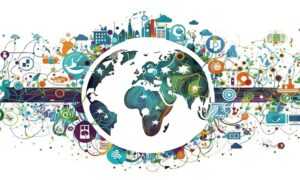Abisola is a technology leader with over nine years of experience in digital transformation and technology advisory services, including business intelligence, Medicaid systems, project management, data management, and systems development. She has worked extensively with healthcare solutions in the public sector. Abisola focuses on driving innovation and broadening the ways clients can leverage data to enhance decision-making through advanced technologies like Artificial Intelligence (AI).
Abstract: Transforming Public Health Surveillance Through AI and IoT explores the integration of Artificial Intelligence (AI) and the Internet of Things (IoT) to revolutionize public health monitoring and disease tracking. The article highlights how these technologies improve real-time data collection, enabling early detection and intervention during health crises, as demonstrated during the COVID-19 pandemic. By leveraging AI’s predictive analytics and IoT’s remote monitoring capabilities, public health systems can enhance decision-making, tailor responses, and streamline health management processes. The study also addresses the ethical considerations, including data privacy and algorithmic bias, that accompany the adoption of AI and IoT in healthcare. Despite these challenges, the convergence of AI and IoT holds significant potential for creating more adaptive and effective public health surveillance systems, fostering a shift towards proactive and personalized health management.
Transforming Public Health Surveillance Through AI and IoT is an emerging field at the intersection of technology and healthcare, where the integration of Artificial Intelligence (AI) and the Internet of Things (IoT) is revolutionizing the collection and analysis of health data for disease tracking and health promotion. This integration aims to improve the real-time monitoring and management of public health concerns, thereby enhancing the capacity for early detection and intervention in disease outbreaks. The importance of this transformation became particularly evident during the COVID-19 pandemic, highlighting the need for robust and adaptable surveillance systems to address the challenges of contemporary public health threats.[1][2]
AI technologies offer advanced capabilities in data analysis and predictive modeling, allowing health officials to harness information from diverse sources such as electronic health records, social media, and news articles. These systems provide actionable insights and trend predictions, enabling more effective public health responses. AI’s adaptive learning capabilities make it superior to traditional methods, which are often static and less effective at forecasting emerging health issues. Notable applications, such as India’s “Arogya Setu” app, exemplify the potential of AI-driven public health solutions to inform and protect communities during critical times.[2][3]
Simultaneously, IoT technologies have introduced new possibilities for remote health monitoring through devices such as wearable sensors and smart home systems. These IoT applications enable continuous tracking of vital health metrics, facilitating individualized care and real-time data collection. However, the widespread adoption of IoT in healthcare faces challenges related to data privacy, security, and the integration of devices into existing healthcare infrastructures. Addressing these challenges is essential to unlocking the full potential of IoT in public health surveillance.[4][5]
The integration of AI and IoT is not without controversies, particularly concerning ethical considerations around data privacy and consent. The collection and analysis of sensitive health data necessitate stringent security measures to prevent unauthorized access and ensure the protection of personal information. Furthermore, the use of AI algorithms must be scrutinized for potential biases that could exacerbate health disparities. As this technological convergence continues to evolve, ongoing research and policy development are crucial to ensure that these systems are deployed responsibly and equitably, maximizing their benefits while minimizing potential harms.[5][6]
Historical Background
Public health surveillance has long been a cornerstone in the prevention and control of diseases, with its primary aim being the identification of early, accurate, and reliable signals of health anomalies and disease outbreaks through a heterogeneous collection of data sources[1]. Traditionally, this process involved systematic gathering, analysis, interpretation, and dissemination of health data to mitigate disease impact[2]. The COVID-19 pandemic underscored the critical need to enhance public health surveillance systems, revealing both the challenges and opportunities presented by modern technologies[3].
The integration of Artificial Intelligence (AI) in epidemiological surveillance has emerged as a promising approach. By utilizing AI technologies, public health surveillance can analyze data from multiple sources—such as electronic health records, social media, and news articles—to identify real-time trends and provide early warnings to public health officials[2]. These advancements aim to improve disease outbreak responses, ultimately protecting public health by offering relevant insights to health officials.
Simultaneously, the Internet of Things (IoT) has been recognized for its potential to revolutionize healthcare by providing new opportunities for disease management and health monitoring. IoT applications in healthcare have shown success in areas like remote patient monitoring, individualized treatment strategies, and streamlined healthcare delivery[4]. However, challenges remain in fully realizing the potential of IoT in healthcare, particularly regarding communication problems and the integration of wearable healthcare devices[5].
The ongoing evolution of public health surveillance, driven by the incorporation of AI and IoT, seeks to address these challenges by enhancing the capacity for real-time data collection and analysis, ultimately transforming how health anomalies and disease outbreaks are detected and managed[3][2].
AI in Public Health Surveillance
Artificial Intelligence (AI) is reshaping public health surveillance by offering innovative ways to detect, monitor, and predict the spread of diseases. By utilizing AI technologies, health officials can analyze vast amounts of data from diverse sources, including electronic health records, social media, and news articles, to identify real-time trends and provide actionable insights for disease outbreak responses[2]. This capability enhances the protection of public health, by enabling more effective disease control measures.
AI-based epidemiological surveillance systems are particularly promising due to their adaptive learning capabilities. These systems dynamically learn from new data, improving their predictive accuracy over time, which makes them more effective than traditional methods that tend to be static and less sensitive to forecasting outbreaks and identifying emerging diseases[2]. For instance, “Arogya Setu,” developed by the Indian Government, leverages AI to deliver real-time contact tracing and self-assessment information, thereby helping individuals stay informed during critical periods such as the COVID-19 pandemic[2].
Moreover, AI opens the door to utilizing novel or underexplored data sources that were not originally designed for epidemiological purposes. The rapid development of the Internet and the Internet of Things (IoT) applications has made ubiquitous social and device sensing capabilities a reality, thereby presenting significant surveillance potential[1]. AI and machine learning (ML) allow systems to analyze data for patterns and predictions without explicit programming, thereby maximizing insights from data and driving public health actions[6].
However, the integration of AI in public health surveillance is not without challenges. AI systems may sometimes identify patterns or trends unrelated to disease outbreaks or miss critical signals due to limitations in the algorithms or data available[2]. This limitation underscores the need for ongoing monitoring and evaluation to ensure the systems remain effective over time.
Additionally, protecting personal data against privacy and security issues is crucial, as AI systems often handle sensitive data such as personal health information or social media activity[2]. Ensuring data is securely stored, protected, and used is vital for maintaining public trust and the overall effectiveness of AI-based public health surveillance systems.
IoT in Public Health Surveillance
The integration of Internet of Things (IoT) technologies into public health surveillance is transforming the landscape of disease monitoring and health management. IoT applications in healthcare span various domains, including pediatric and geriatric care, chronic disease supervision, and fitness management[3]. However, a systematic theoretical analysis highlights the untapped potential of IoT data for public health surveillance[4][3].
Health-monitoring sensors are central to this transformation, as they enable continuous monitoring of vital health parameters such as heart rate, blood oxygen saturation, and respiratory rate[5]. Wearable sensors, powered by IoT technology, facilitate real-time data collection, making it possible to monitor patients remotely[5]. The data generated from these sensors can be transmitted via Bluetooth, Wi-Fi, RFID, and other wireless technologies to smartphones or other connected devices, supporting remote diagnosis and ongoing monitoring[5].
Despite the promising applications of IoT in public health, several challenges persist. Ensuring the user-friendliness, adaptability, and security of IoT systems is crucial for their widespread adoption[5]. Additionally, data privacy and security remain significant concerns, especially when sensitive health information is involved[2]. Researchers emphasize the need for enhanced integration of wearable healthcare devices with emerging technology trends to overcome these barriers and realize the full potential of IoT in public health[5].
Integration of AI and IoT
The integration of Artificial Intelligence (AI) and the Internet of Things (IoT) is transforming public health surveillance by enabling more effective data collection, analysis, and response strategies. AI technologies, with their capability to dynamically learn from new data, enhance the predictive accuracy of surveillance systems, allowing them to identify trends and potential outbreaks with greater sensitivity than traditional methods[2]. This is particularly important in the context of IoT, where numerous interconnected devices, such as wearable sensors and smart home monitors, continuously generate vast amounts of health-related data[5][3].
The IoT architecture facilitates the integration of various data sources, ranging from social media to electronic health records, providing a comprehensive data ecosystem that AI can analyze to monitor and predict health trends in real-time[6][2]. For example, wearable devices equipped with sensors can monitor an individual’s health metrics and communicate this data to medical professionals, enabling remote patient monitoring and individualized treatment plans[4][5]. This real-time data collection and analysis are crucial in creating an automated telehealth ecosystem, where AI can process data to offer insights and predictions that inform public health decisions and interventions[5][2].
Moreover, the combination of AI and IoT in public health surveillance supports the use of big data analytics, which is increasingly becoming mainstream in public health[3]. Through innovative analytical methods such as data integration and visualization, these technologies allow for a more comprehensive understanding of health patterns and outcomes, enhancing the ability to track disease spread and promote health at both individual and community levels[3][2]. This synergy between AI and IoT not only enhances the efficiency and effectiveness of disease surveillance but also has the potential to improve overall healthcare delivery by optimizing resource allocation and improving patient care[4][5].
Applications in Disease Tracking
The integration of Artificial Intelligence (AI) and the Internet of Things (IoT) is transforming public health surveillance by providing innovative applications in disease tracking. AI-based epidemiological surveillance systems leverage AI technologies to analyze data from diverse sources, such as electronic health records, social media, and news articles, enabling the detection, monitoring, and prediction of disease spread in real-time[2]. This real-time surveillance is crucial in providing early warnings to public health officials, allowing for timely responses to potential outbreaks and enhancing the overall effectiveness of public health measures[2].
IoT-assisted wearable devices are increasingly utilized in healthcare for various applications, such as monitoring hemoglobin concentration, respiratory rate, and heart rate[5]. These devices generate data that, when integrated with AI, can help in chronic disease diagnosis and management, including conditions like COVID-19[5]. The combination of AI and IoT technologies enables more accurate disease tracking, assisting healthcare professionals in making informed decisions and optimizing patient care[5].
Furthermore, AI techniques have been applied to infectious disease outbreak detection, providing early warnings and trend predictions that inform public health response strategies[1]. These AI-driven approaches are vital for identifying accurate signals of health anomalies and disease outbreaks from a multitude of data sources, overcoming challenges such as data sparsity and interwoven spatiotemporal dependencies[1].
Despite the advancements, the use of IoT in public health surveillance also brings challenges, such as data privacy concerns, which could affect user acceptance[3]. Efforts to address these privacy and security issues are crucial to maintaining public trust in AI-driven medical technologies[2][3]. Nonetheless, the integration of AI and IoT continues to offer promising potential in revolutionizing disease tracking, enhancing the responsiveness, accuracy, and equity of public health surveillance systems[6].
Health Promotion and Preventive Measures
The integration of Artificial Intelligence (AI) with Internet of Things (IoT) technologies is significantly enhancing health promotion and preventive measures by allowing for more responsive and accurate public health data collection and analysis. Novel approaches to public health data are proving beneficial across various diseases and conditions, enabling public health systems to become more responsive, equitable, and precise[6]. IoT technologies, such as smart home monitors and wearables, provide real-time data that can be leveraged for continuous health monitoring and personalized health recommendations, thus promoting healthier lifestyles and early intervention strategies[3][7].
AI-driven solutions are also transforming preventive measures by improving the speed and accuracy of disease surveillance. For example, AI can automatically detect tuberculosis from chest X-rays, enabling timely diagnosis and treatment[6]. Moreover, real-time surveillance systems powered by AI and IoT can detect disease outbreaks early, providing public health officials with critical information to implement timely preventive actions[2].
In addition to direct health monitoring, these technologies support health promotion through advanced data analysis and user interaction tracking. This enables healthcare providers to offer personalized health advice and improve patient engagement in preventive health strategies[8]. However, to maintain public trust in AI-driven medical technologies, it is crucial to address data privacy and security concerns[2][3].
Challenges and Ethical Considerations
The integration of Artificial Intelligence (AI) with Internet of Things (IoT) technologies in public health surveillance presents numerous challenges and ethical considerations. One of the primary challenges is the protection of data privacy. As IoT devices collect vast amounts of personal health data, the potential for unauthorized access and breaches increases, which raises significant privacy concerns for users[5][3]. These privacy issues may affect the acceptance of IoT technology from the user’s perspective, as individuals may be reluctant to share personal data without adequate assurances of privacy protection[3].
Security is another critical challenge in IoT-based public health surveillance. With medical records being digitized and stored in electronic health records on cloud platforms, they become vulnerable to hacking attempts, thereby compromising the confidentiality and integrity of health data[5]. Addressing security concerns is essential to maintaining trust in the system and ensuring that sensitive health information is adequately protected against cyber threats.
In addition to privacy and security, ethical considerations related to user consent must be addressed. The consent dimension of IoT applications examines whether users are adequately informed about how their data will be used and whether they can independently decide to participate in surveillance programs[9]. Achieving meaningful consent is crucial to respecting user autonomy and building trust in these technologies.
Furthermore, the use of AI and IoT in public health surveillance can inadvertently introduce bias and exacerbate existing disparities. To address these ethical concerns, it is essential to evaluate fairness in machine learning algorithms and take steps to mitigate bias[6]. Ensuring that AI-driven surveillance systems do not disproportionately impact specific groups or reinforce existing inequities is vital for ethical implementation.
Future Prospects
The future prospects of integrating AI with IoT in public health surveillance are vast and promising. As IoT technologies continue to evolve, they hold the potential to significantly enhance public health systems by providing real-time data collection and analysis capabilities. The integration of AI can further drive innovation in this field, unlocking new possibilities for disease tracking and health promotion[7].
Machine learning and artificial intelligence are expected to play pivotal roles in driving the innovation needed to leverage IoT technologies in public health. These advancements could enable predictive modeling of disease outbreaks and enhance the capacity for personalized healthcare strategies[7][5]. The potential for AI-powered IoT systems to streamline healthcare delivery, facilitate remote patient monitoring, and offer individualized treatment strategies is a testament to their transformative potential[4].
However, to ensure the sustained growth and success of these technologies, several challenges must be addressed. Security and privacy concerns remain significant barriers that researchers need to tackle through innovative approaches[7]. Enhancing the affordability of IoT solutions and raising awareness among users and stakeholders is also crucial for widespread adoption[7].
In addition to overcoming these challenges, continuous reevaluation and development of new frameworks for assessing the potentials and threats of such tools are necessary. This includes examining the type, quality, and quantity of data systems require and ensuring that users’ consent rights are respected[9]. Harnessing complementary data sources, such as IoT-based data, alongside traditional public health surveillance systems, presents an opportunity to strengthen existing frameworks and respond more effectively to public health crises[3].
References
[1]Zeng, D., Cao, Z., & Neill, D. B. (2020). Artificial intelligence–enabled public health surveillance—from local detection to global epidemic monitoring and control. Artificial Intelligence in Medicine, 2021, 437–453. https://doi.org/10.1016/B978-0-12-821259-2.00022-3
[2] Anjaria, P., Asediya, V., Bhavsar, P., Pathak, A., Desai, D., & Patil, V. (2023). Artificial intelligence in public health: Revolutionizing epidemiological surveillance for pandemic preparedness and equitable vaccine access. Vaccines (Basel), 11(7), 1154. https://doi.org/10.3390/vaccines11071154
[3] Sahu, K. S., Majowicz, S. E., Dubin, J. A., & Morita, P. P. (2021). NextGen public health surveillance and the Internet of Things (IoT). Frontiers in Public Health, 9, 756675. https://doi.org/10.3389/fpubh.2021.756675
[4] Li, C., Wang, J., Wang, S., & Zhang, Y. (2024). A review of IoT applications in healthcare. Neurocomputing, 565, 127017. https://doi.org/10.1016/j.neucom.2023.11.017
[5] Abdulmalek, S., Nasir, A., Jabbar, W. A., Almuhaya, M. A. M., Bairagi, A. K., Khan, M. A.-M., & Kee, S.-H. (2022, October 11). IoT-based healthcare-monitoring system towards improving quality of life: A review. Healthcare (Basel), 10(10), 1993. https://doi.org/10.3390/healthcare10101993
[6] Centers for Disease Control and Prevention. (2023, July 3). Artificial intelligence and machine learning: Applying advanced tools for public health. https://www.cdc.gov/surveillance/data-modernization/technologies/ai-ml.html
[7]Chataut, R., Phoummalayvane, A., & Akl, R. (2023, August 16). Unleashing the power of IoT: A comprehensive review of IoT applications and future prospects in healthcare, agriculture, smart homes, smart cities, and Industry 4.0. Sensors (Basel), 23(16), 7194. https://doi.org/10.3390/s23167194
[8] Merriam-Webster. (n.d.). Query. In Merriam-Webster.com dictionary. Retrieved October 9, 2024, from https://www.merriam-webster.com/dictionary/query
[9] Fontes, C., Hohma, E., Corrigan, C. C., & Lütge, C. (2022). AI-powered public surveillance systems: Why we (might) need them and how we want them. Technology in Society, 71, 102137. https://doi.org/10.1016/j.techsoc.2022.102137



































